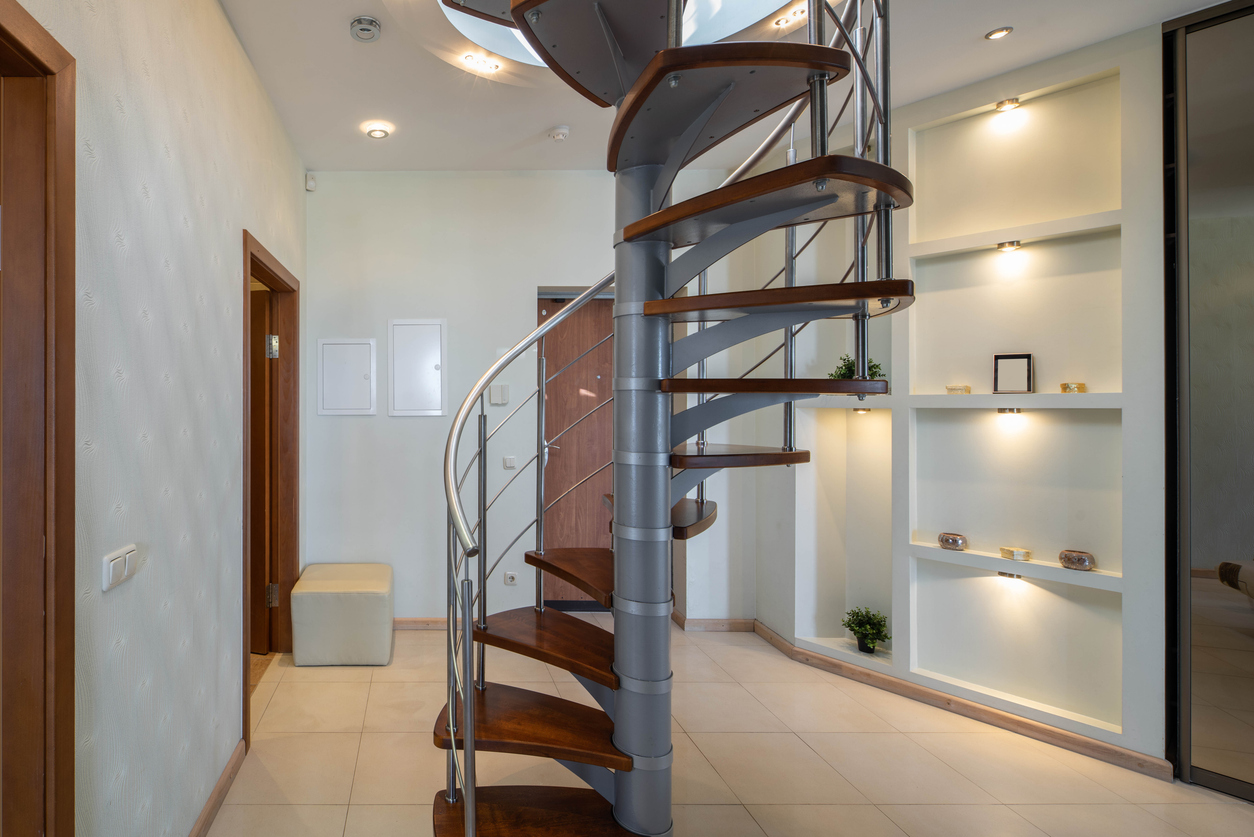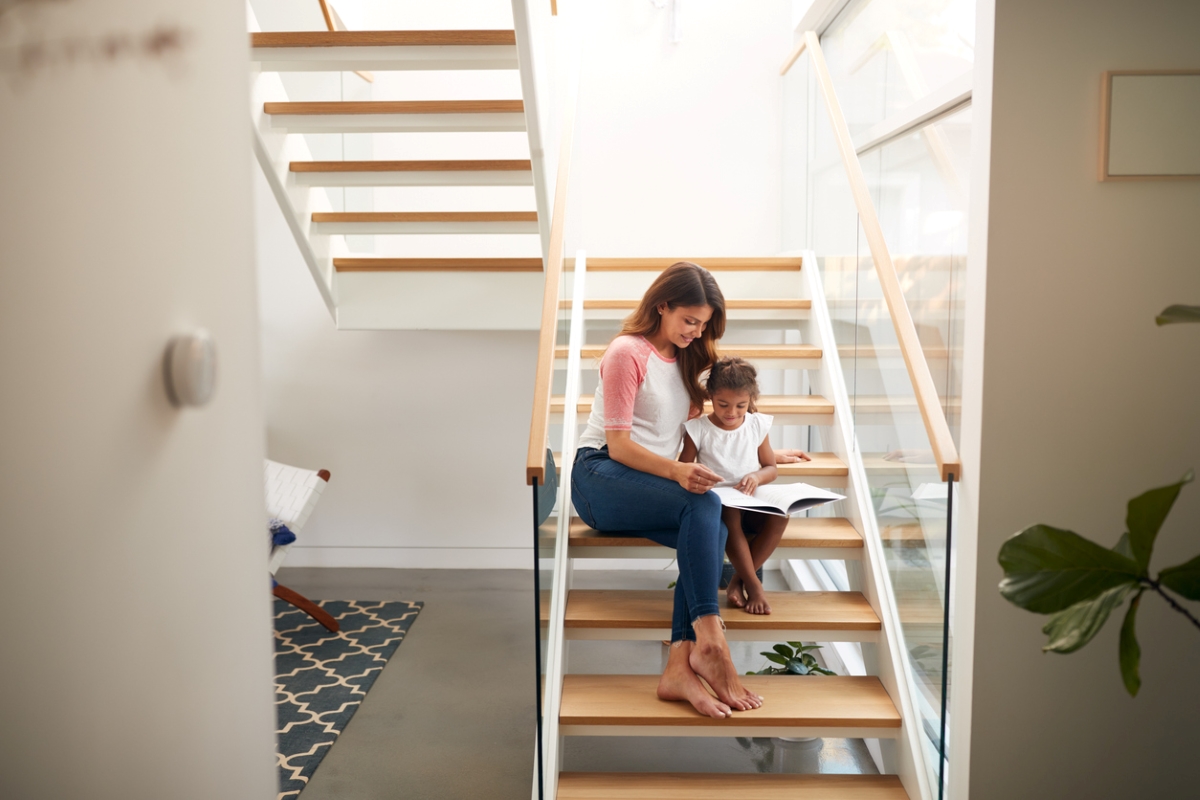We may earn revenue from the products available on this page and participate in affiliate programs. Learn More ›
If you’re remodeling your home—or having a new home built—there are several staircase design ideas to consider. Each type will impact the overall look and feel of your home and can have an impact on functionality. Moreover, a staircase remodel is a considerable investment, so it’s important to make an informed decision that you’ll be happy with for years to come. Ahead, we’ll take a look at nine types of stairs that you may want to consider for your remodeling project.
“No matter which style you choose, make sure to account for things like ceiling height, floor space, building codes, and who will be using the stairs frequently,” says Matt Bigach, co-founder of Nexus Homebuyers in Knoxville, Tennessee. “Proper measurements are key to finding the right fit,” Bigach adds.
1. Straight

One of the most basic types of staircases is straight stairs. These “long stairs” extend directly from one level of a home to the next without any turns or direction changes. This linear option is found in many residential homes. Construction is relatively straightforward, making them a more affordable choice. Vacuuming these stairs can also be easier, since you don’t need to worry about making any turns with the hose.
Occasionally, there may be a central landing placed about half-way up the staircase. This is more common with very long flights. If the stairs are more than 12 feet high, local building codes may even require a landing to be installed near the midpoint of the flight.
Best For: Those on a tighter budget or homeowners looking for a more basic design.
2. Quarter-Turn

Quarter-turn stairs are another option to consider. These are a variation of a straight staircase, but they feature a 90-degree turn with a flat landing somewhere along the flight. The L-shaped design makes these a suitable choice for those looking to install a staircase along the wall or in a corner in order to save space.
One additional benefit of choosing this staircase design over straight stairs is that they can provide a little more privacy between floors by creating a visual blockade. However, because of the support structure they require, expect quarter-turn stairs to be more expensive than straight stairs to install.
Best For: Installing stairs along a wall or in a corner.
3. Winder

At first glance, winder stairs look very similar to L-shaped ones. The key difference in the design lies at the turn. While the L-shape stairs design features a flat landing, winder stairs feature triangular-shaped steps at the corner turning point.
Because of their similar design, Winder and L-shaped stairs offer many of the same benefits. For one, they can both be installed along a wall or corner to conserve space.
The triangular steps along the turn make winder stairs a more attractive option in the eyes of many homeowners, adding a modern touch to a living space. They’re also ideal for smaller homes because they don’t take up a lot of space.
However, like L-shaped stairs, a center support is necessary to support winder stairs, which can make installation more expensive and complex. The odd-shaped triangle steps can also be more challenging to navigate for some users than a flat landing.
Best For: Conserving space while still achieving an elegant look.
4. Half-Turn

As Bigach explains, half-turn stairs “make a 180-degree turn about halfway up with a small landing. They’re a good compromise when you don’t have enough vertical clearance for one straight flight.”
Also called halfback, switchback, or U-shaped stairs, half-turn stairs can help you conserve floor space while adding to the overall aesthetics of your space. With the landing half-way up the flight, they make it possible for individuals with mobility or breathing problems to rest when going up or down.
There are a few downsides to weigh before deciding whether these are the right type of stairs for you. Depending on the size and layout of your space, half-turn stairs may be a bit complicated or impractical to install. Installation will also involve multiple support structures, which can add to the complexity and overall cost.
Best For: Conserving floor space and breaking up a long flight of stairs.
5. Cantilever

“These modern, minimalist stairs seem to float without any visible support underneath,” says Bigach. Unlike other design types, these architectural stairs do not have risers. This makes for open spaces between the steps, creating a sleek and minimalist look.
Bigach shares a few important notes about cantilever stairs. He explains that they “need very solid structural anchoring into the walls.” Moreover, because of the installation and support implication, “they’re also pricier than traditional staircases.”
Keep in mind that the open spaces between the steps could also pose challenges or safety concerns for children, individuals with limited mobility, or pets.
Best For: Modern or minimalist home design.
6. Bifurcated

“When considering a more traditional but grand addition to a property, we often recommend bifurcated stairs,” says Kristin Hintlian, co-owner of Bonsai Builders in Massachusetts.
“Bifurcated stairs start with a wider, single flight at the bottom, which then splits into two narrower flights at a landing. This design can be breathtaking but requires substantial space and budget, making it suitable mostly for larger, high-end projects,” Hintlian notes.
Best For: High-end renovation projects in larger homes.
7. Double

Double staircases are another option for those looking to add a grand entrance to their home. These designs feature two different staircase flights that extend up to a joint landing on the upper floor. Depending on the layout of the home and the overall design vision, the two staircases may run parallel to one another, or they may curve towards the edges of the room.
As you can likely imagine, double staircases take up more space than single versions. Because you are essentially building two separate staircases, a double staircase will cost more to build than other more traditional options.
Best For: Individuals with a large home designing a grand entryway.
8. Curved

Curved interior stairs are often found in formal entryways. Instead of the straight staircase steps that you’ll find with many other varieties, as the name suggests, a curved staircase has a rounded, crescent shape. Their curved design can instantly transform a space, giving it a more sophisticated appearance.
However, curved staircases aren’t a viable option for many homeowners. First, their curved shape consumes a lot of floor space and may not be practical in smaller homes. They are also difficult to design and install, meaning you’ll need to be prepared to spend a pretty penny for a curved staircase. If you’re looking to measure your stairs for carpet, you’ll want to call in a professional for a curved staircase due to the increased challenge of installation.
Best For: Spacious formal entryways.
9. Spiral

“Spiral staircases are an architectural marvel, perfect for limited spaces, and they add a distinct character to any home,” shares Hintlian. “These staircases are cost-effective in terms of the space utilized versus the area needed for other stairs types.” she adds.
Spiral staircases wind up from one level to a hole cut through the floor above. Each step is attached to a vertical support beam that runs between the two levels. Spiral staircases can be used between floors in a home, but they are also used in tighter spaces, such as for accessing a building’s roof.
While they don’t take up much space, there are a few downsides. Hintlian notes that “they can be tricky to navigate, especially for individuals with mobility issues, and moving large furniture between floors can become a logistical challenge.”
Best For: Tight spaces where more traditional stairs would not be practical.


